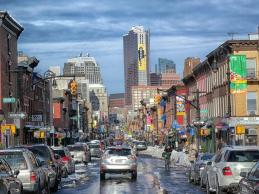The History of Discrimination in Stuyvesant Town

In 1943 there was a serious housing crisis in New York. It was decided that a private company, Metropolitan Life, would develop an area of 72 acres in what was then a dilapidated area known as the gashouse district, planning a complex of 12 and 13 story buildings with 8,579 apartments. There was some opposition to the plan coming from some businesses and the 11,000 residents of the area, but the project proceeded as planned.
The real commotion began when the president of Met Life, Frederick H. Ecker announced to the New York Post that blacks would be excluded from the development, remarking that, “Negroes and whites don’t mix.”
Despite protests and condemnation of this policy from labor organizations, civil rights groups and Jewish organizations, the city quickly approved the plan. The project opened in 1947 with the receipt of 200,000 requests to live there, a fair majority of them, including Dr. Lee Lorch, veterans. According to Dr. Lorch it was well known that it “was going to be an all-white project.” He added, however, that the housing shortage was so severe that there was no way there could be a real boycott of Met Life.
Dr. Lorch added that, “Going there carried an obligation to fight discrimination. That’s the way a lot of people felt.”
